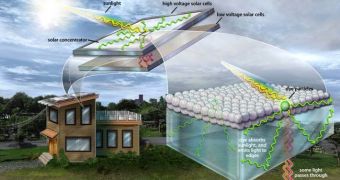Solar cells are currently viewed as the star of alternative energy sources, being able to produce electric energy without the disadvantage of releasing greenhouse gases and other pollutants into the Earth's atmosphere as burning fossil fuels does. Sunlight provides an incredible amount of energy per square meter, although harnessing that energy has proven somehow difficult considering the low efficiency of current solar cell designs.
And to make matters worse, solar cells are also very expensive, which can be easily seen in the US Department of Energy's last year report stating that the amount of energy provided by photovoltaic cells during 2007 totaled only 0.07 percent of the overall output of the US. MIT researchers now claim that by applying a certain type of design, solar panels could be integrated in windows to become more efficient and less expensive at the same time.
The basic idea is that the relatively large surface area of a window would be able to collect sunlight and then focus it on low surface solar cells, thus increasing the electric power output of typical photovoltaic cells. "Currently, the vast majority of solar concentrators track the sun to generate high optical intensities, often by using large mobile mirrors that are expensive to deploy and maintain," said Marc A. Baldo from the Massachusetts Institute of Technology, leader of the study.
By painting two or more dyes on a typical glass sheet, the solar concentrator proposed by MIT decreases the surface area of solar cells to make them fit onto the edges of a flat glass panel. The dyes absorb sunlight across a wide spectrum of wavelengths only to re-emit and concentrate them into different wavelengths useful for the solar cells on the edges of the window.
"Light is collected over a large area like a window and gathered, or concentrated, at the edges. This increases the energy output by a factor of 40," Baldo said.
Curiously enough, this type of design was first proposed more than three decades ago, albeit the concentrator proved too inefficient at that time and the idea was abandoned. Now, the original design was improved by MIT researchers by creating a concentrator out of a mix of dyes allowing a higher level of control over how light is being transmitted to the outer edges of the window.
"We made it so the light can travel a much longer distance. We were able to substantially reduce light transport losses, resulting in a tenfold increase in the amount of power converted by the solar cells," said MIT graduate student Jon Mapel, co-author of the study.

 14 DAY TRIAL //
14 DAY TRIAL //